Imagine a world where your coffee maker starts brewing the moment your alarm goes off, your car communicates with traffic lights to steer clear of traffic jams, and your watch monitors your health and sends updates to your doctor. This interconnected reality is made possible by the Internet of Things (IoT).
IoT focuses on linking everyday devices to the internet, enabling them to communicate with one another, collect data, and make intelligent decisions. From homes and vehicles to factories and hospitals, IoT is revolutionizing how we live, work, and engage with technology. In this blog, we’ll break down the fundamentals of IoT, examine its advantages, and discover how it’s shaping the future in ways you may not have anticipated.
The Internet of Things (IoT) is all about connecting everyday items to the internet, enabling them to exchange data. These items can range from home appliances like refrigerators and washing machines to wearable tech such as smartwatches or even industrial equipment. The main concept behind IoT is that these devices can gather information, share it with others, or be controlled remotely through the internet, enhancing convenience, efficiency, and connectivity in our lives.
Here’s how Internet of things works in simple terms:
- Devices with Sensors: IoT devices come with sensors that gather data. For instance, a smart thermostat can detect the temperature in your home.
- Connectivity: These devices connect to the internet using Wi-Fi, Bluetooth, or other wireless technologies, allowing them to share collected data or receive commands from users or other devices.
- Data Processing: The information collected by IoT devices is sent to a central system, cloud, or another device for processing. For example, a smart fridge might relay data about its contents to an app that notifies you when items are running low or nearing their expiration date.
- Action/Automation: Based on the data, these devices can automatically take action. For instance, a smart irrigation system might activate the water supply when the soil moisture falls below a certain threshold, or a fitness tracker could alert you if you haven’t moved enough throughout the day.
Examples of Internet of things in daily life:

- Smart Homes: Devices like smart lights, thermostats, and security cameras that you can manage remotely through your smartphone.
- Wearables: Fitness trackers or smartwatches that keep track of health metrics such as steps, heart rate, or sleep patterns.
- Smart Cars: Vehicles that can transmit diagnostic information to the manufacturer or even drive themselves using IoT technology.
- Smart Cities: Infrastructure like streetlights, parking meters, and traffic signals that utilize IoT to enhance urban living, conserve energy, or improve public safety.
In short, IoT makes the world smarter by turning everyday objects into “smart” devices that can gather and share information, helping people save time, energy, and improve efficiency. Internet of Things (IoT) is transforming our daily lives and work environments by linking everyday items to the internet. This connectivity enables these objects to communicate and make informed decisions based on the data they gather. Whether it’s increasing convenience in our homes or boosting efficiency in various industries, IoT is automating processes and enhancing intelligence. As the number of interconnected devices grows, IoT is set to foster a more seamless, responsive, and sustainable world, presenting countless opportunities to elevate our quality of life and spur innovation across different fields. By enabling objects to communicate and make the decisions based on real-time data, IoT is transforming everything from our homes to industries. As technology advances, the integration of IoT will only increase, offering new ways to enhance productivity, reduce waste, and make our daily lives simpler and more automated.
Written by Anzar Abdul Hameed & Fathima Sherin
